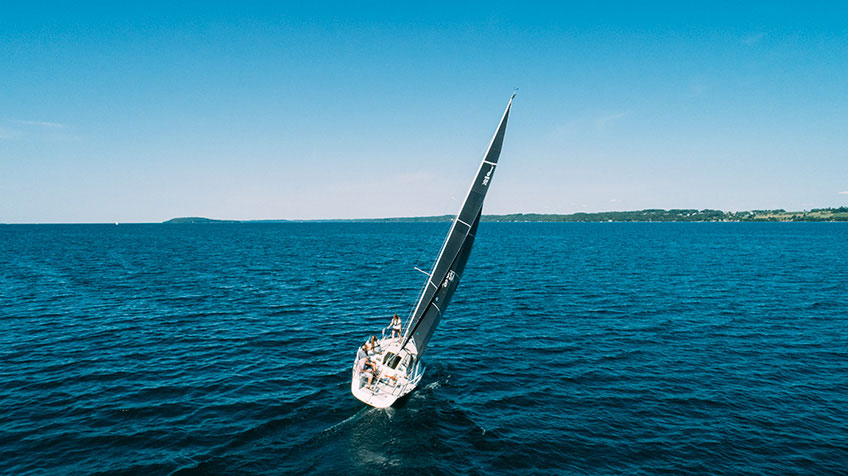Whether you’re relatively new to sailing, or just someone who’s not obsessed with trim tweaking like our Quantum Expert, Joe Cooper, chances are you may know what and where the boom vang is on your boat, but you might not fully understand its power — yet. Small but mighty, this system helps control and maintain mainsail twist, keeping your sail performance dialed in and even offering opportunities to trim with more finesse. Even if you’re a seasoned racer or cruiser, it’s always great to get a refresher. So let’s get back to basics.

As we’ve reviewed, the vang is the principal tool for controlling twist in the mainsail, which can be a critical part of sail control management. The vang also assists in controlling the height of the boom, and can even, in some cases, provide extra stability for safety. Small but mighty, it only comes into play when you need sharp and focused adjustment to the shape of the mainsail, or to counteract too much leech twist because the trimmer has reached the limits on the mainsheet or traveler. On larger racing boats and professional programs, the vang is led to where the mainsheet trimmer sits, and is usually adjusted by the tactician— it takes a refined hand to adjust — though if more than one person can adjust it, all the better. In the same vein, a standard vang control is usually rigged up near the mast, and a crew member may need to crawl up along the cabin top to adjust it, making it a wholly ineffective process. Instead, consider how you might run a control line back towards the cockpit, or perhaps in reach of someone otherwise sitting on the rail, to be able to adjust with ease. The perfect implementation of “if you build it, they will trim it” (or something like that…).
When used properly, the vang is synonymous with control. As a tool, it comes into play in scenarios where you need a way to correct the amount of twist in the mainsail – but if you simply ease the sheet, you also sacrifice power and speed. Instead, tighten the vang to maintain the angle of the boom (and so, the twist) and to increase downward pressure on the leech when easing the sheet or traveler. This reduces the pressure on the sail and on the rudder, thereby assisting in helming or reducing heel. Vang adjustments are particularly useful on bigger wind days with puffy breeze — by easing the sheet while using the vang to control the twist, the apparent wind angle will diminish and help you maneuver through the puff.
How do we know when to adjust the vang? Your upper leech tell-tales on your mainsail will tell you. It can be a useful tool at all angles but for the most part, the vang will come into play when you’re on a beam reach or wider. On these points of sail, because the mainsheet is eased and, if you have one, the traveler is fully down, the vang is the star of the show for controlling twist and maintaining effectiveness — and keeping those tell-tales streaming. Oftentimes, when we sail between 70 and 100 degrees apparent wind angle, depending on the size of the mast, the mainsail is receiving some turbulence from the mast itself, impacting its efficiency. The vang will pull down on the boom and maintain a good upper leech angle, reducing luffing.
When you come up to the wind, to 40-70 degrees apparent, the vang can still be in play. If you eventually do ease the mainsheet and traveler to adjust for any reason without touching the vang, the top of the main will twist off. Instead, you can sail with what's called “vang sheeting.” Utilizing the vang’s function of controlling twist, similar to sheet trimming, the vang tensions the leech, flattening it and managing power. Easing the mainsheet with the vang allows the apparent wind angle on the mainsail to diminish, relieving pressure on the sail and the rudder, spilling air. But, because of the positioning of the vang and its leverage, these adjustments are more precise and maintain power more effectively. Like any other kind of trimming, this technique involves consistent attention and adjustment.
If you’re sailing upwind, presumably close hauled, you want the top tell-tale just streaming. When a puff comes on, or you want to depower, our instinct is to ease the sheet. If you have absolutely no vang on, when you ease the sheet, the top of the sail will twist off, sacrificing the efficiency of the trim. Instead, if the vang is trimmed slightly before you ease the sheet, when you do ease the sheet, the vang will restrain the top of the sail from twisting off, so you can sail flat and fast through the bigger breeze.
The vang is also an excellent tool for in-boom furling systems and even as a backup preventer, as it can help maintain boom angle and height. Because many in-boom furling systems require a specific boom angle, the vang is a perfect way to help hold the boom in place when taking down or putting up your sails, minimizing damage and flogging. You can mark on the vang lines themselves the most effective position for furling to make this task even easier.
In many cruising and even some racing boats, the standard vang that comes with most setups isn’t actually large enough to handle the loads that need to be leveraged for its best effectiveness. The more powerful you can make your vang – say, upgrading from a 4-to-1 to an 8-to-1 purchase ratio, or adding a fairlead or extra block — the more helpful it will be. Talk to your sailmaker about increasing the power of your vang, and how you can bring the control back to the cockpit for added accessibility. These seemingly small adjustments can pay off big time when it comes to racing or cruising performance and comfort.